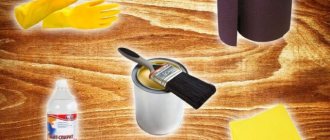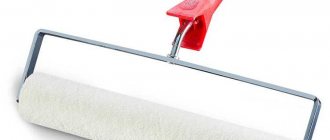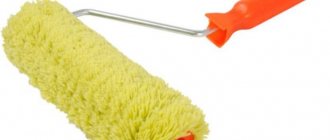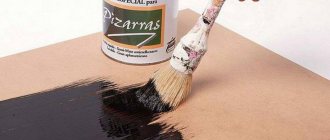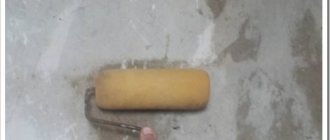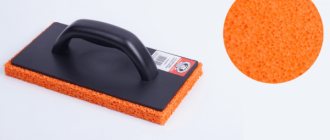Selection of materials
Most modern varnishes are perfect for any type of wood. Therefore, they are successfully used in the mass production of wooden furniture and the design of decorative elements. In practice, the following types of varnish compositions are used:
- Oily. Usually contain synthetic or natural resins. The latter are characterized by a considerable price and are environmentally friendly. After applying such products, a film is formed that protects the surface from moisture.
- Polyurethane. High-quality, as a result of wood coating they form a durable protective layer. This composition is most often used in construction and in the manufacture of many musical instruments.
- Alkyd. Manufactured using synthetic resins and containing a solvent. They are versatile and suitable for covering any wood.
- Acrylic. The main advantage is environmental friendliness. The applied layer makes the base more durable and protects it from moisture. This material is intended for interior work: finishing the ceiling, walls of living rooms.
- Primers. Colorless compositions contain natural oil, after application they prevent the formation of mold and mildew. It is allowed to varnish windows from the outside and entrance doors from the inside.
Modern means can protect even wood that is constantly in water.
Varnishes of various shades are available for sale, with different chemical compositions Source baltija.eu
Conclusion
So, joint rollers are very convenient and effective devices that allow you to quickly and efficiently roll joints of wallpaper and drywall sheets. In addition, they make it convenient to paint surfaces, especially in hard-to-reach places. Using a suitable roller attachment, you can conveniently and quickly process any type of wallpaper.
A paint roller is an excellent choice for those cases when you need to paint a large surface area and a regular brush is no longer enough. The roller is also useful for covering walls with a primer or adhesive solution and applying spectacular textured designs.
The answer to the question of how to choose a paint roller lies in the purpose of this tool, the type of paint, as well as the result that you want to get after painting. We will present the main types of rollers and indicate their scope of application so that the choice for each buyer is as simple as possible.
Methods of varnishing wooden surfaces
Flawless application of varnish on wood is done using special tools. They are selected based on the volume of work to be done and personal preferences.
Roller
Designed for covering smooth surfaces with the material. Using a roller you can quickly cover large areas. Moreover, the varnish will be applied in an even layer. Additionally, you will need to purchase a plastic tray.
The use of a roller is advisable for large areas with a flat surface Source baltija.eu
Strengthening joints
Using a special roller, you can effectively strengthen the joints between plasterboard boards. And this can be done in several ways, the simplest and most effective method is the following. First, the joint between the two sheets is primed, after which a reinforced mesh or paper tape must be applied to the primed surface. There is no need to wait until the primer is completely dry; you can press the paper tape or mesh with a tapered roller along the entire length of the joint.
Read also: Welding heating work prices
If you use a regular tool for this job, the tape will stick to it and, as a result, come off. To avoid this, you can wait until the primer dries on the wall, or you can use a specialized roller without waiting for the primer to dry.
Safety regulations
Regardless of the choice of material, when processing wood you need to follow some recommendations. This will allow you to perform the varnishing properly without harming your health.
Basic Rules:
- The rooms in which the material is applied must be equipped with a good ventilation system and illuminated with natural light. In such conditions, there is a high probability of doing the work efficiently and completely safe for health.
- Particular care should be taken when varnishing outdoor surfaces: dust contaminants may get onto the surface being treated. Also, avoid excessive exposure to sunlight. This may cause a decrease in the quality of the work done.
- When applying varnish, you must adhere to the permissible temperature conditions. According to the instructions, for most materials, when varnishing, the temperature in the room and environment should not be lower than +5°C. After treating the wooden base, it is unacceptable to speed up its drying. This will most likely provoke a violation of technology. If the temperature requirements are not met, bubbles and other undesirable defects often appear on the treated surface.
- All types of paint and varnish work are carried out wearing a mask, goggles, gloves, and a protective suit.
Attention! Most varnishes, especially those with a solvent, are characterized by an unpleasant, pungent odor. Therefore, it is extremely important to provide reliable protection for the respiratory system, and therefore maintain your health.
For safety, surface treatment with varnish should be performed in a special protective suit Source parketista.ru
Features of work
To paint wallpaper or apply glue to the surface of the wall, you can completely dip the roller into the paint and varnish material or treat it with paint on one side, then roll out the roller in a special ditch (bath). Thanks to this rolling, the paint and varnish mixture will be evenly distributed over the entire surface of the roller for wallpaper joints.
After this, you can apply paint to the wall or wallpaper. It is better to do this with a rubber roller. When the process of painting or applying glue is completed, the tool must be thoroughly washed, but you can also remove the old attachment and then install a new, clean attachment in its place.
To make using a roller as convenient as possible, you need to ensure that this device is clean and well-functioning. It is important to periodically clean the roller so that its rotation is uniform and the roller does not jam. Experts recommend centering the roller along the internal metal rod, which is its axis. Without centering, the tool will apply the paint material in stripes, as a result of which the quality of the paint will be significantly affected.
Step-by-step instructions for coating wooden bases with varnish
The process of applying material to wood includes several successive stages. Each of them is important and mandatory. To perform the job properly, it is necessary to take into account even the smallest nuances.
Surface and material preparation
To properly varnish wood, you first need to prepare the base. Since even under several layers of material it is impossible to hide small defects on the wood, they should be removed even before the varnishing procedure begins. The only exception is the case when it is deliberately required to emphasize the texture of the base.
Important! Before implementing any treatment, the wood must be properly dried. On the eve of processing, the percentage of its humidity should not exceed 15%.
Most modern paint and varnish compositions, as a rule, are used without preliminary preparation. But there are also products that require dilution. This should be done strictly according to the instructions. For example, alkyd compounds can be diluted with white spirit.
Manual grinding is carried out using sandpaper - a special abrasive tool Source elka-palka.ru
Grinding
The cleaned planed wood base must be sanded with 80 to 100 grit sandpaper.
If there is any old coating of any kind on the surface, it must be removed. This can be done using sandpaper with 40-60 grit. It is quite difficult to remove an unnecessary layer of material by hand, therefore it is recommended to use a grinding device to perform such work.
For further processing, a vibrating grinder is used. The direction of sanding, as well as the grain of the wood, must necessarily coincide, otherwise scratches will subsequently be noticeable even through several layers of varnish.
After finishing sanding, the surface to be treated should be cleaned of any accumulated dust with a soft brush. When the base area is too large, it is better to use a vacuum cleaner.
The use of a grinding machine speeds up the work and greatly facilitates the work. Source stroypomochnik.ru
Primer
When using any type of varnish, it is important to strictly follow the attached instructions for use. In some cases, manufacturers recommend priming the wooden base the day before varnishing. Such a requirement should not be ignored. Otherwise, when applying the product, adhesion (adhesion) may be weak, and after a while the varnish surface will begin to gradually deteriorate.
The primer is selected according to the recommendations for the use of varnish. Usually its manufacturers also produce related materials: various solvents, primers. They also recommend using them. It is permissible to use products of other brands: it is important to understand chemicals. There is always a possibility that the selected compositions will turn out to be incompatible. After interaction of the latter, an undesirable reaction may occur.
Preliminary application of primer to wood ensures better adhesion after varnishing Source kraski-net.ru
Flaws
Joint rollers have some disadvantages:
- It is quite difficult to process soft surfaces. A regular roller is not suitable for any textured or fiberglass wallpaper strips. If you use a hard plastic conical roller for embossed wallpaper, it can press in the design, which will ruin the appearance. However, if you choose a soft nozzle, you can control the pressure exerted on the surface, and also paint embossed wallpaper well. But with a soft nozzle, a beginner is unlikely to cope with such a tool; this requires certain skills. If you have no experience in painting and wallpapering, it is better to use not a roller, but some soft tool, for example, an ordinary rag, for high-quality processing of wallpaper;
- high consumption of paint and varnish material. It is generally accepted that rollers consume paint much faster than, for example, a brush. Of course, it is not very easy to control the flow rate while working with a roller, especially if a person does not have experience in the field of painting. If the amount of paint is very limited, it is better to use a brush.
Advice from professionals
There are several professional tips that can help you achieve the best results:
- The application of any decorative coating requires a clean surface, so the base must not only be cleaned, but also dried after washing. Preliminary surface treatment is required for floors made of any material (concrete, tile, wood, plywood).
- When preparing the surface of a concrete floor, quartz sand should be added to the primer. It will make the floor less slippery. In addition, to increase the strength of the cement surface and get rid of dust, you can use a special impregnation topping.
- When preparing wooden flooring for varnishing, it is better to treat the surface with oil or a wax mixture. This treatment will help protect the surface under intense loads.
- For plywood floors, it is better to pre-treat with an acrylic primer, which protects this material well from moisture and mold.
- The readiness of the surface after primer treatment can be checked by placing your palm on the floor. If the composition does not stick to your hand, then you can start painting.
You will learn more about how to properly paint a floor in the following video.
It seems that there is nothing complicated in choosing a paint roller, but in fact it is an important element for painting that requires special attention. The roller determines how the paint will adhere to surfaces, how convenient it will be to paint, whether it is suitable for reuse, and so on. Not only the dimensions of the handle and the roller itself are important, but also the materials that were used for it.
Therefore, for its readers, “Dream House” has prepared a full review that will help you choose a high-quality paint roller and easily cope with painting any surface and any type of paint.
Read also: Star and triangle connections differences
How to choose a paint roller
Roller markings
When choosing a roller, you should always check the markings. As a rule, it contains an alphabetic and numerical designation:
- the Ø icon and the number indicate the diameter of the rounded part of the roller, units of measurement are millimeters;
- the letter designation is the material of the roller, as well as the surface for which it is intended (not always indicated), for example, BB is a velor roller, and VMP is a chalk roller for the floor;
- the digital designation following the letters is the length of the roller cylinder, indicated in millimeters.
For example, Ø50 BB-200 is a velor paint roller with a diameter of 50 mm and a length of 200 mm.
When we have to paint large areas, we don’t hesitate to buy a paint roller. It seems that this is a completely solvable problem. However, the wide range of painting tools can sometimes be confusing. How to choose the right paint roller and which rollers are best to use for repairs will be discussed in this article.
But before we get into the varieties, let’s figure out how a paint roller works.
Paint roller device
A roller can be called one of the main painting tools. It is a simple design consisting of a cylindrical roller attachment, which is movably mounted on the handle.
The length of the roller handle ranges from 300 to 500 mm. If, to perform work, for example when painting a ceiling, a larger reach is needed, then the handle is extended with a special telescopic extension.
There are two types of handle designs - clasp and double-arm.
The clasp handle or clasp is a curved metal rod with a diameter of 6 or 8 mm. The nozzle is fixed on the clasp with a pin or a special coupling. This is the most common paint roller design.
The double-arm handle has the shape of a fork, which holds the movable cylindrical attachment on both sides.
According to the method of fastening the nozzles, they are distinguished:
— detachable rollers , in which the nozzle can be replaced with a new one after it is completely worn out. This roller is convenient because you can choose several types of replaceable attachments with different coats for the existing handle.
One of the varieties of split rollers is a frame roller. It is distinguished by the design of the handle, which has a flexible wire or polymer frame for attaching the nozzle. The nozzle, in turn, does not have a rigid base, so it is convenient when working with uneven, deeply embossed surfaces.
— rigid rollers with permanently attached attachment and handle. When the coat wears out, the paint roller is thrown away along with the handle.
Size matters
One of the determining factors when choosing a paint roller is its size. It is determined by the width of the nozzle, which ranges from 50-300 mm, as well as its diameter - 40-100 mm. Based on these parameters, there are:
— mini-rollers up to 150 mm wide. Their purpose is to paint hard-to-reach places, corners and small areas.
- medium-sized rollers , 150-250 mm wide and 50-90 mm in diameter. The most common among painters and are universal.
— facade rollers with a width of more than 250 mm and a diameter of more than 80 mm. They can be classified as professional tools. This roller is equipped with an intermediate layer of padding and an improved bearing system. As a result, the roller rotates smoothly and the paint splatters less. Working with a facade roller requires a certain skill.
It seems quite obvious that for large volumes it is preferable to take a larger roller - this is a clear reduction in labor costs. However, in reality it turns out to be quite the opposite.
Read also: The principle of operation of a torque wrench
A larger roller absorbs more paint. As a result, his weight increases. And working with a heavy tool leads to rapid fatigue. Consequently, productivity drops.
Therefore, the best option when choosing a paint roller is medium size.
Fur coat no joke
Next, when choosing a paint roller, you should pay attention to the fur coat. This is the name given to the coating of the cylindrical nozzle. The coat is made from various materials and is selected depending on the purpose of the roller, the type of surface and the type of paint and varnish material.
Paint rollers intended for painting and priming are distinguished by coat material into:
- polyurethane or foam rollers - suitable for working with adhesives, varnishes, paints and water-based primers. Its advantages include low cost. The disadvantages are paint splashing, low wear resistance, unevenness of the painted coating, fear of compositions with chemically aggressive components.
In fact, a foam roller is a disposable tool. Its use is justified when priming small areas and smooth surfaces.
- fur rollers made of artificial (polyester) and natural fur - suitable for working with all types of paints and surfaces. The exception is lime paints, which are not recommended for use when working with rollers made of natural fur.
They are characterized by good absorption and uniform distribution of painting compounds. The disadvantage is the fragility of the fur coat, its instability - the possibility of caking and lint loss.
- polyamide rollers or thread rollers - suitable for all types of painting compounds and surfaces. Ensures uniform coloring. They have good absorbing and holding ability. They are characterized by increased wear resistance and the possibility of repeated use. Easy to clean. The disadvantage of a thread roller is that the paint splatters when the pile length is long.
- polyacrylic rollers or velor rollers - their characteristics are similar to polyamide rollers. The disadvantage is the low absorbency. Therefore, when working, the velor roller has to be frequently dipped in paint, which increases the working time.
There are special rollers for certain types of painting work. The most common of them are:
— rubber pressure roller for wallpaper. Used for rolling seams and removing air bubbles when wallpapering walls.
— textured rollers – designed for decorative painting and creating relief surfaces. They are used with textured finishing materials - structural plasters, putties, decorative paints.
The corrugated coating of the nozzle can be made hard - from rubber, foam plastic or soft - from textiles, foam rubber.
The surface topography also plays a role when choosing a paint roller. The deeper it is, the longer the fur coat's pile should be. For example,
- for smooth surfaces - metal, plastic, plasterboard - use a roller with a pile of up to 5 mm. - for rough surfaces - putty, concrete, wood - use a roller with a pile of average length 5-20 mm. — for large-relief surfaces, rollers with a pile length of more than 20 mm are used.
Quality indicators of a paint roller
A wide selection of paint rollers of domestic and foreign production makes us think about their quality. There are several signs and techniques that help determine the quality factor of an instrument.
- Squeeze the fur attachment in your hand and release - a high-quality roller will quickly restore its original shape.
- The quality of the instrument is evidenced by a neat fur coat, with flat, inconspicuous seams and without protruding threads. Longitudinal stripes on the fur coat indicate that the fur coat is sewn and can be replaced if necessary. As a rule, this is a sign of a professional and high-quality instrument. Transverse or oblique stripes are an indicator of glued fur coats that cannot be replaced. The wear resistance of such a tool is not high.
- Resistance to aggressive compounds is determined by the number of stripes located on the fur coat. The more of them, the more stable the roller.
Paint roller care
In order to be able to reuse a paint roller you need to know how to properly care for it.
Firstly, it is recommended to use different rollers for different types of paint.
Secondly, at the end of the work, the roller must be freed as much as possible from paint residues (rolled over the grid) and washed with a solvent. The solvent is selected depending on the type of paint. Next, you need to shake the roller well several times and hang it until completely dry. It is not recommended to twist it and dry it in a different position, because... the fur coat will wrinkle and the roller will lose its shape.
Thirdly, if the roller will be used in the coming days, you can save it by placing it in a bucket of paint and wrapping it in plastic.
Now, knowing all the intricacies of choosing a paint roller, you can buy the necessary tool and start repairing.

